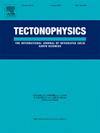Mapping a seismic barrier across the Shumagin Gap from satellite goce derivatives direct and inverse modeling
IF 2.7
3区 地球科学
Q2 GEOCHEMISTRY & GEOPHYSICS
引用次数: 0
Abstract
The earthquake potential of the segment known as the Shumagin gap, located along the southwestern Alaska convergent margin, has been debated for over 40 years. This portion of the megathrust has not experienced a historically great earthquake with a magnitude (Mw) greater than Mw = 8.0, or at least none has been recorded in the instrumental era, exhibiting a moderate to low slip deficit. On 22 July 2020, an Mw = 7.8 thrust-fault earthquake ruptured a deeper portion of the megathrust along the eastern edge of the Shumagin Gap. Aftershocks following this event, including an Mw = 7.6 strike-slip earthquake on 19 October 2020, delineated an approximate north-south fault zone. Later, on 29 July 2021, an Mw = 8.2 thrust-fault earthquake ruptured the Semidi segment to the East. In this work, we examined the coseismic behavior of the Shumagin gap and adjacent Semidi segment along the Alaska margin from direct and inverse models obtained from satellite-derived gravity data. The distribution of the vertical gravity gradient shows a saddle point topography along the Shumagin Gap where the aftershocks of the July 2020 Mw = 7.8 earthquake concentrated in a nest. The gravity disturbance and the inverse model of mass anomalies also show an along-strike segmentation. Anomalous mass inferred along the Shumagin Gap, is consistent with the seismicity, focal mechanisms, and recently published works, suggesting that this segment hosts a seismic barrier (along-strike) that limits earthquakes with magnitudes Mw > 8.0. On the other hand, an across-strike (along-dip) segmentation is inferred from Tzz, which is consistent with vertical motion models. Comparison of the interplate coupling and b-values distribution to the vertical gravity gradient, allowed mapping main asperities in the region suggesting that the area to the west of the Shumagin gap could host a great megathrust earthquake in the future.
利用卫星地表导数直接和逆模型绘制横跨舒马金地堑的地震屏障
位于阿拉斯加西南辐合边缘的舒马金断裂带可能发生地震,这个问题已经争论了40多年。这部分巨型逆冲构造在历史上没有经历过震级(Mw)大于8.0的大地震,或者至少在仪器时代没有记录过,表现出中度到低滑动亏损。2020年7月22日,一场7.8兆瓦的逆冲断层地震使舒马金裂谷东部边缘的大型逆冲断层更深部分破裂。此次地震之后的余震,包括2020年10月19日发生的7.6级走滑地震,描绘了一个大致的南北断裂带。后来,在2021年7月29日,一场8.2兆瓦的逆冲断层地震使东部的半米迪部分破裂。在这项工作中,我们通过卫星重力数据获得的正模型和逆模型,研究了阿拉斯加边缘的Shumagin缺口和邻近的Semidi段的同震行为。垂直重力梯度的分布呈现出沿Shumagin裂谷的鞍点地形,2020年7月Mw = 7.8级地震的余震集中在一个巢状区域。重力扰动和质量异常逆模型也表现出沿走向分段。沿Shumagin断裂带推断出的异常质量,与地震活动性、震源机制和最近发表的研究成果一致,表明该断裂带拥有一个地震屏障(沿走向),限制了Mw >级地震;8.0. 另一方面,从Tzz推断出了一个跨走向(沿倾角)分段,这与垂向运动模型一致。通过对板块间耦合和b值分布与垂直重力梯度的比较,可以绘制出该地区的主要陡岩,这表明在未来的Shumagin断裂带西部地区可能会发生一次大逆冲地震。
本文章由计算机程序翻译,如有差异,请以英文原文为准。
求助全文
约1分钟内获得全文
求助全文
来源期刊

Tectonophysics
地学-地球化学与地球物理
CiteScore
4.90
自引率
6.90%
发文量
300
审稿时长
6 months
期刊介绍:
The prime focus of Tectonophysics will be high-impact original research and reviews in the fields of kinematics, structure, composition, and dynamics of the solid arth at all scales. Tectonophysics particularly encourages submission of papers based on the integration of a multitude of geophysical, geological, geochemical, geodynamic, and geotectonic methods
 求助内容:
求助内容: 应助结果提醒方式:
应助结果提醒方式:


